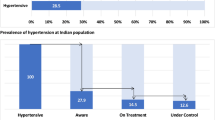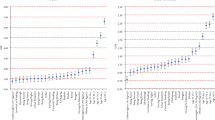Abstract
Early detection is the cornerstone of hypertension management; still majority remains undetected until complications arise, especially in poor-resource settings. Paucity of information regarding undiagnosed and uncontrolled hypertension in eastern India thus called for a detailed investigation involving a representative sample of adults in Malda, one of the poorest districts in the region. In a cross-sectional study, between October 2013 and July 2014, using multistage random sampling with probability-proportional-to-size, 18 028 consenting adults were interviewed. Diagnosed cases were defined as uncontrolled if they still had hypertensive level of blood pressure (according to JNC-VIII criteria) while those detected during this study were defined as undiagnosed. Descriptive and regression analyses were performed using SAS version 9.3.2. Among 18 028 participants, 4695 (26.04% (95% confidence intervals: 95% CI=25.40–26.68)) had hypertension, of which 3937 (83.86% (82.80–84.91)) were undiagnosed and 548 (72.30 (69.10–75.49)) had uncontrolled hypertension. Relatively older subjects (adjusted Odds ratio (aOR)41–60 years=0.34 (95% CI=0.26–0.43) and aOR>60 years=0.29 (0.21–0.38)), who were divorced/separated/widowed/widower (aOR=0.76 (0.61–0.95)), had higher education (aOR=0.61 (0.43–0.88)), better socio-economic status (SES) (aORMiddle=0.77 (0.60–0.99) and aORUpper=0.64 (0.48–0.85)) and urban residence (aOR=0.44 (0.36–0.55)) were less likely while subjects who belonged to backward castes (aOR=1.37 (1.15–1.64)) were more likely to have undiagnosed hypertension. Odds of having uncontrolled hypertension were higher among participants aged >60 years (aOR=2.25 (1.27–3.99)). Burden of hypertension (diagnosed and undiagnosed) was high in Malda district of West Bengal. Significant predictors of undiagnosed hypertension were young age, backward caste, poor education and lower SES, while older subjects had poor control. Thus, appropriate surveillance targeting these at-risk groups might be effective in controlling hypertension in similar poor-resource settings.
This is a preview of subscription content, access via your institution
Access options
Subscribe to this journal
Receive 12 digital issues and online access to articles
$119.00 per year
only $9.92 per issue
Buy this article
- Purchase on Springer Link
- Instant access to full article PDF
Prices may be subject to local taxes which are calculated during checkout

Similar content being viewed by others
References
Lim SS, Vos T, Flaxman AD, Danaei G, Shibuya K, Adair-Rohani H et al. A comparative risk assessment of burden of disease and injury attributable to 67 risk factors and risk factor clusters in 21 regions, 1990-2010: a systematic analysis for the Global Burden of Disease Study 2010. Lancet 2012; 380 (9859): 2224–2260.
World Health Day 2013: measure your blood pressure, reduce your risk, Media centre, World Health Organization (WHO), 2013. Available from http://www.who.int/mediacentre/news/releases/2013/world_health_day_20130403/en.
Lopez AD, Mathers CD, Ezzati M, Jamison DT, Murray CJ . Global and regional burden of disease and risk factors, 2001: systematic analysis of population health data. Lancet 2006; 367 (9524): 1747–1757.
Singh RB, Suh IL, Singh VP, Chaithiraphan S, Laothavorn P, Sy RG et al. Hypertension and stroke in Asia: prevalence, control and strategies in developing countries for prevention. J Hum Hypertens 2000; 14 (10–11): 749–763.
Gupta R . Trends in hypertension epidemiology in India. J Hum Hypertens 2004; 18 (2): 73–78.
Srinath Reddy K, Shah B, Varghese C, Ramadoss A . Responding to the threat of chronic diseases in India. Lancet 2005; 366 (9498): 1744–1749.
Jeemon P, Reddy KS . Social determinants of cardiovascular disease outcomes in Indians. Indian J Med Res 2010; 132: 617–622.
Controlling high blood pressure, Key messages of World Health Day 2013. WHO global health days. Available from http://www.who.int/campaigns/world-health-day/2013/key_messages/en/.
Anchala R, Kannuri NK, Pant H, Khan H, Franco OH, Di Angelantonio E et al. Hypertension in India: a systematic review and meta-analysis of prevalence, awareness, and control of hypertension. J Hypertens 2014; 32 (6): 1170–1177.
Joshi SR, Saboo B, Vadivale M, Dani SI, Mithal A, Kaul U et al. Prevalence of diagnosed and undiagnosed diabetes and hypertension in India—results from the Screening India's Twin Epidemic (SITE) study. Diabetes Technol Ther 2012; 14 (1): 8–15.
The Seventh Report of the Joint national Committee on Prevention, Detection, Evaluation, and Treatment of High Blood Pressure (JNC 7). National Heart, Lung and Blood Institute, US Department of Health and Human Services, 2004. Available from http://www.nhlbi.nih.gov/files/docs/guidelines/jnc7full.pdf.
Mohan V, Deepa M, Farooq S, Datta M, Deepa R . Prevalence, awareness and control of hypertension in Chennai—The Chennai Urban Rural Epidemiology Study (CURES-52). J Assoc Physicians India 2007; 55: 326–332.
Islam FM, Bhuiyan A, Chakrabarti R, Rahman MA, Kanagasingam Y, Hiller JE . Undiagnosed hypertension in a rural district in Bangladesh: The Bangladesh Population-based Diabetes and Eye Study (BPDES). J Hum Hypertens 2015; 30 (4): 252–259.
Ingsathit A, Thakkinstian A, Chaiprasert A, Sangthawan P, Gojaseni P, Kiattisunthorn K et al. Prevalence and risk factors of chronic kidney disease in the Thai adult population: Thai SEEK study. Nephrol Dial Transplant 2010; 25 (5): 1567–1575.
Singh RB, Fedacko J, Pella D, Macejova Z, Ghosh S, de Amit K et al. Prevalence and risk factors for prehypertension and hypertension in five Indian cities. Acta Cardiol 2011; 66 (1): 29–37.
Bhardwaj R, Kandori A, Marwah R, Vaidya P, Singh B, Dhiman P et al. Prevalence, awareness and control of hypertension in rural communities of Himachal Pradesh. J Assoc Physicians India 2010; 58 (423-424): 429.
Misra A, Khurana L . Salt intake and hypertension: walking the tight rope. J Assoc Physicians India 2007; 55: 401–403.
Radhika G, Sathya RM, Sudha V, Ganesan A, Mohan V . Dietary salt intake and hypertension in an urban south Indian population—[CURES - 53]. J Assoc Physicians India 2007; 55: 405–411.
Devi P, Rao M, Sigamani A, Faruqui A, Jose M, Gupta R et al. Prevalence, risk factors and awareness of hypertension in India: a systematic review. J Hum Hypertens 2013; 27 (5): 281–287.
Biswas M, Manna CK . Prevalence of hypertension and sociodemographic factors within the Scheduled Caste community of the District Nadia, West Bengal, India. High Blood Press Cardiovasc Prev 2011; 18 (4): 179–185.
Hernandez-Hernandez R, Armas-Padilla MC, Armas-Hernandez MJ, Velasco M . Hypertension and cardiovascular health in Venezuela and Latin American countries. J Hum Hypertens 2000; 14 (Suppl 1): S2–S5.
Hypertension Study Group. Prevalence, awareness, treatment and control of hypertension among the elderly in Bangladesh and India: a multicentre study. Bull World Health Organ 2001; 79 (6): 490–500.
Basu S, Millett C . Social epidemiology of hypertension in middle-income countries: determinants of prevalence, diagnosis, treatment, and control in the WHO SAGE study. Hypertension 2013; 62 (1): 18–26.
Kaur P, Rao SR, Radhakrishnan E, Rajasekar D, Gupte MD . Prevalence, awareness, treatment, control and risk factors for hypertension in a rural population in South India. Int J Public Health 2012; 57 (1): 87–94.
Chinnakali P, Mohan B, Upadhyay RP, Singh AK, Srivastava R, Yadav K . Hypertension in the elderly: prevalence and health seeking behavior. N Am J Med Sci 2012; 4 (11): 558–562.
Prince MJ, Ebrahim S, Acosta D, Ferri CP, Guerra M, Huang Y et al. Hypertension prevalence, awareness, treatment and control among older people in Latin America, India and China: a 10/66 cross-sectional population-based survey. J Hypertens 2012; 30 (1): 177–187.
Sathish T, Kannan S, Sarma PS, Razum O, Thankappan KR . Incidence of hypertension and its risk factors in rural Kerala, India: a community-based cohort study. Public Health 2012; 126 (1): 25–32.
Yadav S, Boddula R, Genitta G, Bhatia V, Bansal B, Kongara S et al. Prevalence & risk factors of pre-hypertension & hypertension in an affluent north Indian population. Indian J Med Res 2008; 128 (6): 712–720.
Das SK, Sanyal K, Basu A . Study of urban community survey in India: growing trend of high prevalence of hypertension in a developing country. Int J Med Sci 2005; 2 (2): 70–78.
Bansal SK, Saxena V, Kandpal SD, Gray WK, Walker RW, Goel D . The prevalence of hypertension and hypertension risk factors in a rural Indian community: a prospective door-to-door study. J Cardiovasc Dis Res 2012; 3 (2): 117–123.
Daugherty SL, Masoudi FA, Ellis JL, Ho PM, Schmittdiel JA, Tavel HM et al. Age-dependent gender differences in hypertension management. J Hypertens 2011; 29 (5): 1005–1011.
Farag YM, Mittal BV, Keithi-Reddy SR, Acharya VN, Almeida AF, Anil C et al. Burden and predictors of hypertension in India: results of SEEK (Screening and Early Evaluation of Kidney Disease) study. BMC Nephrol 2014; 15: 42.
Gupta R, Deedwania PC, Achari V, Bhansali A, Gupta BK, Gupta et al. Normotension, prehypertension, and hypertension in urban middle-class subjects in India: prevalence, awareness, treatment, and control. Am J Hypertens 2013; 26 (1): 83–94.
Hajjar I, Kotchen TA . Trends in prevalence, awareness, treatment, and control of hypertension in the United States, 1988-2000. JAMA 2003; 290 (2): 199–206.
Baliga SS, Gopakumaran PS, Katti SM, Mallapur MD . Treatment seeking behavior and health care expenditure incurred for hypertension among elderly in urban slums of Belgaum City. Community Med 2013; 4 (2): 227–230.
Acknowledgements
The study was funded (Grant No. 65/56/2012-13ECD-II) by Indian Council of Medical Research (http://icmr.nic.in/Grants/Grants.html). We are hereby acknowledging our gratitude to Professor Dr VI Mathan (Former Chair, National Institute of Epidemiology, Chennai and Chairman of the Scientific Advisory Committee, NICED, Kolkata) and Dr Sekhar Chakrabarti (Scientist G and Director in Charge, National Institute of Cholera and Enteric Diseases, Kolkata) for critically reviewing the proposal and the result. We also acknowledge the support of Dr VM Katoch (Director General, Indian Council of medical Research, Government of India) and Dr Rashmi Arora (Scientist G, Indian Council of Medical Research) for providing necessary logistic and administrative support. The Office of the Chief Medical Officer of Malda provided necessary permission and logistic support for the study. In addition, we also acknowledge the cooperation of the participants and the project staff.
Author information
Authors and Affiliations
Corresponding author
Ethics declarations
Competing interests
The authors declare no conflict of interest.
Rights and permissions
About this article
Cite this article
Kanungo, S., Mahapatra, T., Bhowmik, K. et al. Patterns and predictors of undiagnosed and uncontrolled hypertension: observations from a poor-resource setting. J Hum Hypertens 31, 56–65 (2017). https://doi.org/10.1038/jhh.2016.30
Received:
Revised:
Accepted:
Published:
Issue Date:
DOI: https://doi.org/10.1038/jhh.2016.30
This article is cited by
-
Predictors of Control Status of Hypertension in India: A Systematic Review and Meta-analysis
Journal of Prevention (2024)
-
Undiagnosed hypertension and associated factors among adults in ethiopia: a systematic review and meta-analysis
BMC Cardiovascular Disorders (2023)
-
Prevalence of uncontrolled hypertension and its associated factors in 50–74 years old Iranian adults: a population-based study
BMC Cardiovascular Disorders (2023)
-
Uncontrolled hypertension and associated factors among adult hypertensive patients in Ayder comprehensive specialized hospital, Tigray, Ethiopia, 2018
BMC Cardiovascular Disorders (2019)
-
Cognitive impairment and hypertension in older adults living in extreme poverty: a cross-sectional study in Peru
BMC Geriatrics (2017)



